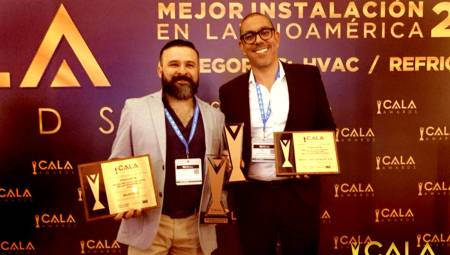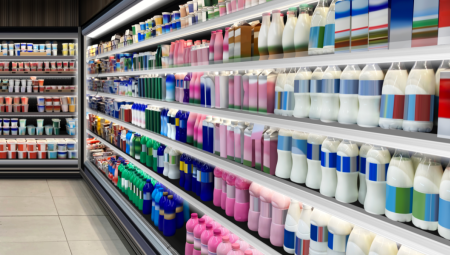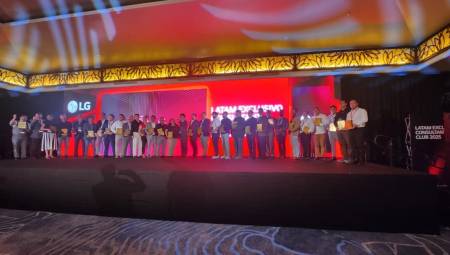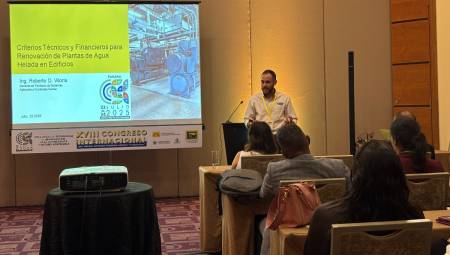 Industrial refrigeration is a fundamental component, but not the only one, that guarantees the health and good condition of meat products. Refriaméricas 2011 was the stage to delve into the techniques used in this field.
Industrial refrigeration is a fundamental component, but not the only one, that guarantees the health and good condition of meat products. Refriaméricas 2011 was the stage to delve into the techniques used in this field.
by Alejandra García Vélez
The use of refrigeration systems for microbial control in slaughter plants is essential to guarantee the quality of the final product, which is why it is necessary to have increasingly careful processes.
Precisely, the Engineer Florentino Torres, manager of the Colombian company TM Consultants, was in charge of addressing this issue during the last edition of Refriaméricas 2011 and categorically stated that "refrigeration is part of a quality management process".
In that sense, it should not be considered as the only option for the proper conservation of meat, but should be part of a process that includes the conditions of the equipment and points to a comprehensive quality management system.
"We should not believe that refrigeration as such is the process of preserving meat, it is really one of the many interrelated processes that aim to maintain the quality of the product," Torres said.
In addition, the speaker pointed out that "the public increasingly demands more food safety, better processes and reliability. Regulatory agencies are pushing harder and harder and we in the industry need to be aware and responsible about this issue."
The importance of microbial control cannot be denied, especially since any error in that regard is directly reflected in the health of consumers. In fact, the latest figures revealed in this regard during the Global Food Safety Conference 2011 indicated that one million eight hundred thousand deaths a year in the world are the result of failures in food safety.
This is due, according to Torres, to the fact that it is mistakenly believed that with refrigeration the errors made during processing can be fixed, when in reality there are highly dangerous microorganisms that resist cooling conditions of up to -1.5ºC. In addition, stronger bacteria and more resistant to thermal processes and antibiotics are appearing.
During his conference Torres emphasized that there is no single industrially viable technology to produce the total elimination of pathogens from meat, "the compendium of many strategies and technologies must be used to achieve that control," he said.
Step-by-step control
An important question is the current situation in Latin America regarding microbial control in its slaughter plants. In this regard, Torres said that although there are some very good plants with structured and established quality systems, that is the exception and not the rule.
Most of the plants are just incipient in their quality control programs and are limited to complying with local regulations to continue operating but there is no awareness of the importance of producing with a food safety approach, thinking about the final consumer and the community in general, said the speaker.
For his part, Engineer Ernesto Sanguinetti, engineering division manager of Cold Import S.A., said that it is also a continuous task of the authorities to find and close clandestine slaughterhouses that do not have a license to operate and, even worse, when they do not meet the requirements of health and microbial control.
In that sense, Torres said that food security begins from the farm and is not an isolated process delegated to processing in slaughter plants. "From feeding, fasting, transporting the animals we are guaranteeing the microbiological quality of our meat," he said.
For his part, Sanguinetti mentioned that in order to achieve successful refrigeration, which guarantees the conservation of meats as long as possible, it is very important to create by technical and hygienic means conditions that prevent the growth or multiplication of microorganisms.
The expert also insists that these procedures must begin before the animal is slaughtered, and must continue throughout the process of slaughter, refrigeration, transport and until its sale to the consumer. He also pointed out that if an adequate refrigeration process is carried out, the products can be kept fresh for up to three or four weeks.
For the preservation of meat products beyond four weeks, freezing must be resorted to, ensuring in the center of the product a temperature of at least -18ºC, explains the Cold Import official.
However, he makes an annotation that reaffirms the importance of microbial control from the beginning of the slaughter process "the most important precondition for the conservation of meat before and during refrigeration or freezing lies in the number of microorganisms being as small as possible".
In that sense, remember that the main sources of pollution are the skin, hairs or feathers of the animal, the abdominal tract of the same, the floor of the workplaces, the cisterns and the quality of the water used, as well as the quality of the air, the buckets, the hands, tools and suits used by the staff.
International quality
Finally, Florentino Torres said that, as a constructive criticism, he considers it pertinent to make a call to the manufacturers of cold rooms that do not think or take into account very little the contamination and asepsis factor of the same. "The designs of the cold rooms should also focus on microbial control, facilitating the possibility of periodic cleaning and disinfection of these."
He also pointed out that those who work in this field should not conform to local regulations, but should seek international certification. "This must be driven by senior management, involving the entire management, technical and operational team so that both structural and mental changes are generated that allow progress towards continuous improvement," Torres explained.













